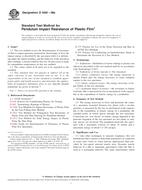We need your consent to use the individual data so that you can see information about your interests, among other things. Click "OK" to give your consent.
ASTM D3420-08a
Standard Test Method for Pendulum Impact Resistance of Plastic Film (Includes all amendments And changes 12/17/2014).
Automatically translated name:
Standard Test Method for Pendulum Impact Resistance of Plastic Film
STANDARD published on 1.11.2008
The information about the standard:
Designation standards: ASTM D3420-08a
Note: WITHDRAWN
Publication date standards: 1.11.2008
SKU: NS-23591
The number of pages: 6
Approximate weight : 18 g (0.04 lbs)
Country: American technical standard
Category: Technical standards ASTM
Annotation of standard text ASTM D3420-08a :
Keywords:
film, impact, impact resistance, pendulum, pendulum impact, Ball burst test, Dynamic ball (pendulum) burst test, Impact resistance--plastics, Pendulum test, Plastic sheet and film, ICS Number Code 83.140.10 (Films and sheets)
Additional information
| Significance and Use | ||||||||||||||||
|
Like other techniques to measure toughness, this test method provides a means to determine parameters of a material at strain rates closer to some end-use applications than provided by low-speed uniaxial tensile tests. Dynamic tensile behavior of a film is important, particularly when the film is used as a packaging material. The same uncertainties about correlations with thickness that apply to other impact tests also apply to this test (see section 3.4 of Test Methods D 1709). Hence, no provision for rationalizing to unit thickness is provided. Also, no provision is made for testing at non-ambient temperatures. This test method includes two procedures, similar except with regard to sample size: Procedure A for 60-mm diameter and Procedure B for 89-mm diameter (commonly called the “Spencer”). The data have not been shown relatable to each other. Several impact test methods are used for film. It is sometimes desirable to know the relationships among test results derived by different methods. A study was conducted in which four films made from two resins (polypropylene and linear low-density polyethylene), with two film thicknesses for each resin, were impacted using Test Methods D 1709 (Method A), Test Method D 3420 (Procedures A and B), and Test Method D 4272. The test results are shown in Appendix X2. Differences in results between Test Methods D 1709 and D 4272 are expected since Test Methods D 1709 represents failure initiated energy while Test Method D 4272 is initiation plus completion energy. Some films have shown consistency when the initiation energy was the same as the total energy. This statement and the test data also appear in the significance and appendixes sections of Test Methods of D 1709 and D 4272. |
||||||||||||||||
| 1. Scope | ||||||||||||||||
|
1.1 This test method covers the determination of resistance of film to impact-puncture penetration. Knowledge of how the impact energy is absorbed by the specimen while it is deforming under the impact loading, and the behavior of the specimen after yielding, is not provided by this test. No provision is made for nonambient temperatures in this test method. 1.2 The values stated in SI units are to be regarded as the standard. 1.3 This standard does not purport to address all of the safety concerns, if any, associated with its use. It is the responsibility of the user of this standard to establish appropriate safety and health practices and determine the applicability of regulatory limitations prior to use. Specific hazards statements are given in Section 7. Note 1—There is no known ISO equivalent to this standard. |
||||||||||||||||
| 2. Referenced Documents | ||||||||||||||||
|
We recommend:
Updating of laws
Do you want to be sure about the validity of used regulations?
We offer you a solution so that you could use valid and updated legislative regulations.
Would you like to get more information? Look at this page.




 Cookies
Cookies
